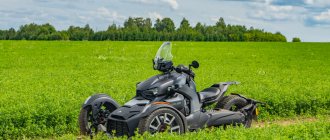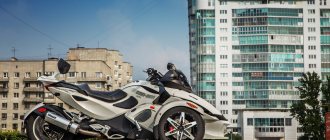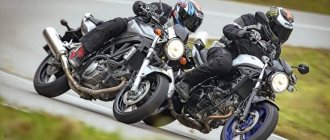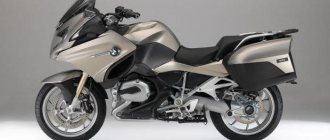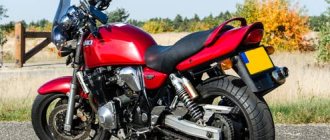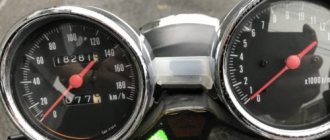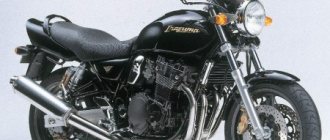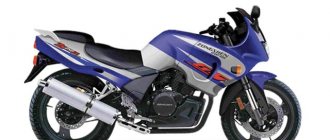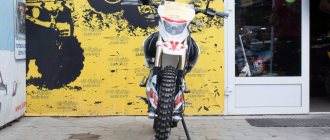So I got around to describing my BMW, or, as I dubbed it, “bomb carrier.” Why is this so? Because the capacity of the cases turned out to be gigantic, and the sound of the boxer, developed by a company with a history in aircraft manufacturing, is like the most propeller-driven “bomb carrier” in low-level flight from the First World War (by the way, for those who don’t know, the BMW logo is not stylized propeller, unlike the established stereotype, but only represents the colors of the Bavarian flag). Moreover, this “two-wheeled aircraft” is equipped with modern electronics and excellent protection from the encroachments of nature on the “reputation” of the rider. But first things first.
000_moto_0711_016
BMW R1200RT: sports tourer, 2010, 1170 cm³, 110 hp, 230 kg, RUB 1,026,000.
BMW R1200RT: sports tourer, 2010, 1170 cm³, 110 hp, 230 kg, RUB 1,026,000.
I drive a Honda Gold Wing, my neighbor in the garage drives a Pan-European. Every time I came to the garage, I involuntarily compared both devices. “Golda” has everything you need on a long journey (and even what you don’t need), while “Europe” has practically nothing except a couple of funny “crazy stuff”. But this is also a “tourist” type, and for almost the same money! To myself, I called this class of motorcycles “sub-tourer”.
With such skepticism, I went to BMW Rusland Trading to pick up a test BMW R1200RT 2010. But after the first kilometers, doubts began to dissipate. The motorcycle is a muscular, robust one. The company positions the RT as a dual-purpose motorcycle: both for the city and for long trips. I managed about 800 km on Moscow streets and 6500 on the roads of Karelia and the Arctic, as well as Norway, Finland and the Baltic states.
I didn’t have to get used to the motorcycle - the ergonomics were calculated perfectly: I sat down and went. The weighty dimensions are deceptive - the dry weight is only 230 kg, which is 50 kg less than, for example, the ST1300 Pan-European. The motorcycle is easy to control at any speed, and maneuvering in city traffic is no more difficult than on the street - the dimensions are quite acceptable. Well, on the track he is the king! The engine power, even when loaded, is enough to quickly accelerate, which is very important, for example, when overtaking oncoming traffic on native “two-lane” roads. However, there is one thing - the gearbox. Due to the close row, you have to switch more often than you would like. On the highway you hardly notice this, but when driving around the city you will have to work with your paw.
The brakes are perfect - they stop firmly, without skidding or wobbling, in any weather. The brake system with ABS is of a semi-combined type: the lever on the steering wheel acts on both wheels, and the pedal only on the rear one. This option is more effective than the “Golda” (the pedal is on the front and rear, and the lever is only on the front), because when maneuvering it is more convenient to use the lever on the steering wheel.
The RT is an asphalt motorcycle, but the suspension is almost identical to the GS (the latter has slightly more suspension travel and a slightly thicker fork leg). The system is well known - Telelever and Paralever work well both on the broken roads of the Kem parish and in the difficult turns of the Norwegian “serpentines”. The motorcycle runs smoothly, without any hiccups. And the feature of this model is the new ESA II remote suspension adjustment system, where spring stiffness can be adjusted. Not preload, but stiffness: two springs (soft and hard) are located one inside the other, and the load on each of them is adjusted using a servo drive. To change the settings, you just need to select one of the options in the computer menu: “driver”, “driver + luggage”, “driver + passenger + luggage”. Damping settings are selected using a button on the remote control right on the go from three options: Comfort, Normal or Sport. “Comfort” mode is really comfortable, like on an old Cadillac. True, during sharp maneuvering there is a “floating stern” effect, but this is only an effect. Engage "sport" mode and the RT sticks firmly to the road. True, here we have to remember that our roads are not mirrors.
By the way, about mirrors. On RT they are unique and are located in the fairing ebb below the steering handles. That is, at the top of the mirror you see your hand, and below it - what is happening behind and on the sides of you. The wind protection of the R1200RT is quite decent - tested in the Arctic and storm gusts of the North Cape. But this is still not “Golda”, and you can’t do without a raincoat. Electric windshield. On a touring trip, the highest position is comfortable, when the flow of the headwind passes over the helmet, allowing you to ride even with the flip-up chin raised. In the rain, on the Gold you need to crane your neck to see the road over the water-filled glass, but here you simply lower it to eye level. The new RT has changed its shape to reduce wind noise, which is important for a motorcycle with a built-in audio system. It is also different: instead of a CD player there is a radio, but with USB and TRS (mini-jack) inputs for any media. The sound quality is quite decent, but after 120 km/h you can’t hear much from a pair of small speakers. There are now button controls for the audio system under the left hand on the inside of the fairing. On the remote control, the wheel controls only the sound and switches program tracks.
An important criterion for a tourer is the autonomous range. Low consumption is common for Bavarian “opposite” cars. In the 90–140 km/h mode, RT consumes plus or minus 5 liters of gasoline per 100 km, which is one and a half times more economical than the same Pan-European (not to mention the Gold Wing). You can travel 500 km on one 25-liter tank, even in a mixed cycle. The on-board computer will show the range on the remaining fuel (as well as the oil level, tire pressure, “outboard” temperature, average fuel consumption). But the meter writes off the last 100 km much faster than you actually drove! In the deserted north of Norway I almost went dry.
There is an opinion that the injection engine of the past R1200RT is capricious in terms of fuel. This one happily consumed both 95 and (in the absence of the latter) 92 gasoline. I did not notice any difference in engine performance or thrust. Also, a story about the oil gluttony of the BMW “boxer” travels from mouth to mouth. Having received a motorcycle with a mileage of 6000 km, I noticed a significant lack of oil. The service people were surprised, they filled it with oil and gave me half a liter for topping up. But after 8000 km, not a drop was lost. So I’ll chalk up the low-level incident to an oversight by the mechanics or the zealousness of other “test drivers,” perhaps trying to make the poor RT take off.
One of the most important factors in long-distance driving is the comfort of the “fifth point”. The seat is a real, but perhaps the only disadvantage of the model. My wife and I didn’t have as much pain in our “iron asses” after passing the standard on the old “Gold” as after 500 km on the new RT. This drawback was confirmed by other owners of this aircraft, who saved themselves by installing tuning saddles. But there are also advantages. Firstly, the driver's seat is height adjustable in two positions. Secondly, the driver and passenger saddles (as well as the steering wheel grips) are heated with two modes, which was very helpful in the Arctic. At temperatures “above zero”, the Low mode is quite enough, at High you feel like you’re sitting on a frying pan, and it’s better not to handle the handles without gloves!
Another criterion is cargo capacity. 32-liter side panniers are standard equipment on the motorcycle. Comfortable, but not very big. The upper one (49 or 28 l) is purchased separately. Don’t be stingy if you use the motorcycle for its intended purpose, that is, in real long-distance driving, and not in front of the girls at the Lookout. Although the latter will be grateful for the comfortable backrest. The motorcycle is also equipped with an anti-theft system, GPS navigator, cruise control, additional sockets and much, much more. The list of options and devices opens up almost limitless possibilities for its improvement.
Buying a BMW R1200RT
Sorry, I'm already sold!
As I wrote earlier, the choice fell on the Beemer not so much because that’s what I wanted, but because “normal Beemers” began to be made before the “polished” Japanese analogues appeared. And in the end, being fanatically in love with the FJR1300, I bought... a Beemer. Because finding one in good condition and with a mileage of up to 20 thousand km (albeit a German “import”) for an amount that suits me turned out to be easier and faster than waiting for an FJR. In addition, I perfectly understood that if I was fined on CBF, then on such a “jet fighter” like the FJR (or, even better, GTR) it wouldn’t be enough. Beamer seemed calmer and more balanced. In addition, “something different”: from the manufacturer to the handling feel and the boxer engine, in contrast to the “four” (cylinders). As a result, I was also very pleased with the upright landing - after CBF, I realized that in this configuration I could, as it turned out, drive more than one hundred kilometers without much strain, and both FJR and Kawasaki GTR are still sports tourers with an emphasis on the first word and a slightly inclined landing. If the trend continues, then there should be a cruiser next :).
The purchase itself was somewhat unexpected. “My” copy was discovered after a fairly regular, but at the same time lazy, combing of sites. After thinking a little, I decided to do a “test drive” and then see what’s what. When I saw the R1200RT on site, I realized that I might not get away with it “just like that.” And when I drove the first few kilometers, I realized that the bike was made “for me.” Everything is in its place (well, except for the “thoroughbred” turn switches, which you “will have to get used to”), comfortable fit (later the details came to light, but more on that later), handling is excellent, the presence of a cruise simply touched me (although not as much as after first experience of use on a Harley). After arriving back at the dealer, I couldn’t help but start bargaining, and in the end... we unexpectedly agreed. They accommodated me halfway, offered me a reasonable price, and added options. In general, it was impossible to refuse :).
It took almost a week to prepare, including getting the numbers (just imported from Deutschland Germany). I had a technical inspection and a week later I left my CBF (trying not to get too upset about it) in the dealer’s parking lot, switching to a gray miracle of German motorcycle construction. So, the “shaving flight” began.
004_moto_0711_016
In 2010, BMW made a number of changes to the RT family.
Like the all-terrain R1200GS, the asphalt tourer receives an updated 1170cc DOHC boxer from the HP2 Sport and some other changes. Power remained the same - 110 hp. at 7750 rpm, but torque increased from 115 Nm to 120 Nm at 6000 rpm. Thanks to the new exhaust valve, power is distributed more evenly across the entire rev range. Another new feature is the ESA II electronic suspension adjustment system. To improve aerodynamics, the shape of the glass, fairing and front wing has been slightly changed. There are new remote controls on the steering wheel (analog with the K1300 family). The seats and audio system have also been changed. In 2010, BMW made a number of changes to the RT family. Like the all-terrain R1200GS, the asphalt tourer receives an updated 1170cc DOHC boxer from the HP2 Sport and some other changes. Power remained the same - 110 hp. at 7750 rpm, but torque increased from 115 Nm to 120 Nm at 6000 rpm. Thanks to the new exhaust valve, power is distributed more evenly across the entire rev range. Another new feature is the ESA II electronic suspension adjustment system. To improve aerodynamics, the shape of the glass, fairing and front wing has been slightly changed. There are new remote controls on the steering wheel (analog with the K1300 family). The seats and audio system have also been changed.
Motorcycle lovers are divided into 3 categories: BMW fans. Opponents who think that BMW-break expensive sucks. And people who like BMWs but don’t look at them because they talked to the second category :) I want to express my IMHO as the owner of my 3rd BMW motorcycle. In particular, we will talk about the second generation of the R1200RT tourist. I decided to add a little remarks after writing: Guys and girls. In no way am I campaigning for BMW, I’m just expressing my opinion as an owner. After all, these are the most interesting opinions. Isn’t it so? If you think that “The Honda is driving and the Boomer is being repaired,” don’t read this post because I have no faith :) In general, the best bike is the one you have in your garage.
Prehistory
The motorcycle was purchased in 2014. Issue 11/7. Mileage 39t.km. Maximum configuration. Complete drain with the exception of expansion tanks (caps) from Wunder and from it the oil cooler and clip-on spacers are protected (a must for RT). Additionally, the bike is equipped with a set of original arches and valve cover protection.
I bought it to replace the K1200R (review), which was sold for 2 reasons: excessive power in the city and inconvenience when traveling further than 400 km (although I also drove 1500 km from the city with a high windshield)
Before that, I was the proud owner of another BMW R1150R (mini review) of which I have the most good memories. I still think it's a wonderful classic with one of the nicest dashboards in the class. Even at current prices for motorcycles, it is an excellent option for purchasing in the “inexpensive but with ABS” class. Unlike subsequent bikes, it’s as simple as 2 kopecks. Absolutely any operations, including “deep repairs,” can be done, if not on your knees, then in a garage with a lift and good tools.
What's on board
Classic air-oil boxer with 1170 cubes. The power remained unchanged compared to the previous 1200 family. It is equal to 110 hp (by the way, it produces the same amount on the wheel - it was measured). Shafts were added, essentially copying the nuances from the BMW HP2 Sport. The drive is of course cardan (my love :) )
Among the equipment, it is worth noting electronic suspension control ESA (9 modes), Traction, Antiwheel, audio system with usb (from a flash drive or with Android or iOS) and +aux+Bluetooth for navigation headsets and other things. Joystick control (multi control ring) on the steering wheel with almost everything you can. Tire pressure sensors. Electrically adjustable wind deflector. Heated grips. Heated seats driver + passenger (can control himself). Immobilizer + security system. Cruise control. ABS is of course also present (this has been a mandatory condition for me when choosing a bike for the 4th season)
Power: 110 hp at 7750 rpm Torque: 120 Nm
Tires - front: 120/70 ZR 17 - rear 180/55 ZR 17
Measurements and Weight
Length: 2230 mm Width with mirrors: 904 mm Seat height: standard - 820-841 mm (adjustable), Weight: 229 kg Fuel tank capacity: 25 l
Passport data on speed and acceleration
Acceleration 100 km/h: 3.8 s Top speed: 200+ km/h
Feelings after the season
The design is controversial. German. Very seasoned. I would even say military. The bike does not take your breath away like a Ducati or Moto Guzzi. No. There’s just an understanding that in front of you is a thing that you worked on a lot. It was done well. And it’s expensive. There is not even a hint of savings anywhere. I won’t lie - this makes the owner very happy. Delight in motion. Bomber in both sound and feel. The season started at temperatures of +3 and ended with the first snow. I simply did not know such riding comfort before RT. Nothing but small drops from oncoming cars reaches the driver. If you want “the wind in your face,” lower the windshield a little with the button and get what you are looking for (we also blow out the helmet in the heat).
Engine and everything around . Sound! For some, it's no good with a stock muffler. for some (me) it’s the best because I don’t want to get tired of the “voice” of the engine when traveling. But the voice is there. Opposite :) It makes me happy. I miss the popping sounds when releasing the gas on the K1200R a little, but I’ll survive. Since the R1150R had absolutely similar weight, we are surprised. RT is 2 times larger in volume. Higher. At the same time, it is definitely more powerful (this is very noticeable compared to the 1150 engine, which produced a maximum of hp on the 1150RT 95 hp and produced them differently) and taxiing is similar (RT is one of the shortest wheelbase bikes in the class). Consumption in the city stopped for me by 6.1 liters (average consumption is automatically reset every 1000 km) and 4.8-5 liters at a speed of 150 km/h. In general, I think that BMWs are extremely economical motorcycles. Sometimes I read with horror comments that on the FZ1 (what I remember) the consumption is closer to 10ke... The power is sufficient. In the first two gears the bike tends to go into a wheelie. This is greatly facilitated by the weight distribution when driving with a passenger and the short wheelbase - I cannot say that the face is loaded as much as I would like. This is also proven by the “emptiness” of the steering wheel that appears at speeds above 170 (with saddlebags installed). It is also surprising that in the entire 1200 line from BMW, only the RT does not have a steering damper installed (and as the settler corrected me on the 1200GS). I can’t confirm whether it’s required (I’ve never caught even a minimal wobbler), but it’s not there. I believe in engineers - if they don’t exist, they don’t need them. With all of the above, you listen to music, it doesn’t blow, it doesn’t drip, and you only need a raincoat in a downpour. I don’t know how, but in light rain I come to work completely dry. At speeds up to 100 mph it is quite possible to smoke (I don’t practice it). The hands are also perfectly protected from the oncoming flow, but at the same time, with a slight change in the position of the hand, the gloves are blown over. Very convenient. The RT's wind and mud protection is excellent.
In this model, they don’t just criticize but note the non-standard rear-view mirrors. They are “automotive” type and are built into the fairing. What can I say: I think it’s a matter of habit. The mirrors are large. The usable area is larger than the standard mirrors of most bikes. I am very pleased, but some people put additional mirrors on the steering wheel using them from the F series, in my opinion. Some owners of this motorcycle install xenon and/or additional lights. My opinion: this is not required. 2 lamps illuminate the road by 5 points. True, there is a dependence on the type of lamps. I installed Philips Motovision lamps - the illumination of the road is strikingly different from conventional lamps. There is a manual dial for the headlight range control. I actually use it when loading the bike as a number 2 and luggage.
All the delights of tire pressure sensors (this is incredibly convenient, friends!). Dashboard light sensor, electric glass drive, butt heating, cruise, Esa!!! Music = you start to love all these cute things from the first ride. I’d especially like to highlight the electronic oil level. It’s very convenient. Started the bike. Warmed it up (if it’s cold outside the bike will warn you about this with a flashing icon indicating the temperature :) ). And at the beginning of the ride I received the data about tire pressure and oil level. I don’t know how to live without this now :) I want to say only one thing to spiteful critics and skeptics: I have experience owning 3 BMW motorcycles. So: nothing broke, did not fall apart, did not glitch, and the bikes were in service only for maintenance moments and that’s all. All three were not purchased new. I don’t consider the faulty wiring on the R1150 to be a breakdown because there was a banal wire break (in the braid, 4 out of 12 wires burst due to tension) due to the fact that the previous owner did not lay it according to the marks that BMW engineers specifically indicate (holes and grooves for stitches) . I can only say one thing about the reliability of BMW: it is more than sufficient (well, except perhaps for the nuances of the Rotax engine on the F series). On the K1200R, for example, the mileage was 67 thousand at the time of sale, which, you agree, is a decent mileage for a hyperstreet (163 hp). This motorcycle has not seen any breakdowns since 2006 until the day of sale. I know that the current owner does not experience problems even now.
Let's return to RT (part two in progress)
009_moto_0711_016
The BMW Navigator IV navigation system is good old Garmin.
BMW has selected the best of what is available on the navigator market today. Works perfect if you load maps. The standard preload is very conditional and displays only the main tracks. Take care of this, otherwise you will have to drive like this... The BMW Navigator IV navigation system is good old Garmin. BMW has selected the best of what is available on the navigator market today. Works perfect if you load maps. The standard preload is very conditional and displays only the main tracks. Take care of this, otherwise you will have to go like this...
Motorcycle BMW R 1200RT Fire 2009 review
The BMW R1200RT is a true tourer. He doesn't care about rain and cold. If a goal is set, this motorcycle will get to it, one way or another, and deliver its rider to it with maximum comfort. Bavarians know a lot about good motorcycles.
The BMW R1200RT touring motorcycle is a relative newcomer to the company’s lineup. It's not as luxurious as the BMW K1600GT, but if the latter can be compared to a limousine, then the exact analogy for the R1200RT would be some comfortable and powerful German sedan. This motorcycle has everything to make the trip as enjoyable as possible.
The BMW R1200RT engine, coupled with a 6-speed gearbox, is borrowed from the famous “goose” - the R 1200 GS model. The air-liquid-cooled two-cylinder boxer engine stands out for its excellent and yet balanced characteristics - 125 hp, 125 nm of torque. It is equally good both at the start, when it is able to instantly pick up speed, and during long trips, when you need to maintain cruising speed hour after hour. A noticeable dip in the BMW R1200RT engine is only felt at the very end of the upper rev range. However, this is not a sportbike, right? At the same time, no parasitic vibrations bother the motorcyclist. Marvelous.
Traditionally for BMW motorcycles, the R1200RT is stuffed with all kinds of electronics. Traction control monitors traction and many other factors, and the on-board computer allows you to switch the engine to one of three operating modes - dynamic, urban and designed for driving in rainy weather. In particular, the “rain” mode will not allow a sudden opening of the gas to throw the motorcycle into a skid, without giving more power to the wheel than necessary.
The BMW R1200RT suspensions are, without exaggeration, gorgeous. They are completely borrowed from the Bavarian touring flagship BMW K1600 GT. A fairly wide range of settings allows you to adjust the suspension to suit your needs. At the same time, they are good for fairly sharp maneuvers, obediently moving the motorcycle to a new trajectory, as well as for long rides, including on asphalt that is not of the best quality. And the aforementioned traction control system is the pride of BMW Motorrad. She vigilantly monitors a bunch of parameters at the same time and protects the overly dashing biker.
A nice feature of the BMW R1200RT is the hill start assist system, similar to that installed on many modern cars. If you need to move the motorcycle and at the same time prevent it from rolling back, this system will carefully hold the brake. Miracles, and that's all. In any case, on the BMW R1200RT, whose dry weight is about 275 kg, it will not be superfluous.
The touring class puts forward its own demands on motorcycles, and one of them is the range without refueling. The BMW R1200RT is fine with this point. The volume of the gas tank is 25 liters. Fuel consumption is from approximately 6.5 liters per hundred and above. It's worth filling with AI-95 - the injector is quite demanding on the quality of the fuel. But with a quiet ride, the R1200RT is capable of traveling 300-400 km on one tank.
As for comfort and ease of operation, the Bavarians are doing well with this. Of course, the BMW R1200RT is a heavy and large motorcycle, which imposes certain restrictions, but it is comfortable to sit on, the instrument panel is perfectly readable at any time of the day, and all control devices are located where sound logic dictates they should be. And the extremely comfortable standard seats do not evoke the slightest desire to change them for others.
Wind protection is also excellent. The standard windshield of the BMW R1200RT does not interfere with visibility, and at the same time perfectly protects from wind and rain, covering not only the rider’s body, but also his hands. However, in case of particularly cold weather, BMW designers equipped the motorcycle with heated not only handlebars, but also seats.
The braking system is, of course, good - it's a BMW! Two discs in the front, one in the back - practically a standard. Brembo brakes work like a Swiss watch, so a heavy motorcycle stops very efficiently, and the ABS works like a charm. There is not the slightest desire to modify the brake system of the BMW R1200RT.
Based on all of the above, one conclusion can be drawn. This motorcycle has only one serious drawback - the price. In addition, if you want to buy not a “naked” BMW R1200RT, but with additional options like built-in navigation, panniers and heating, you will have to shell out even more.
Go to the entire range of BMW motorcycles, on this page you can find BMW R 1200RT Fire motorcycles from other years of production and information about them
011_moto_0711_016
Using the wheel, you can adjust the sound and switch program tracks.
On the one hand, it’s convenient, on the other hand, when you try to turn on the turn signals, you often click the program at the same time, especially if your hands are wearing gloves. Using the wheel, you can adjust the sound and switch program tracks. On the one hand, it’s convenient, on the other hand, when you try to turn on the turn signals, you often click the program at the same time, especially if your hands are wearing gloves.
012_moto_0711_016
RESULT. My skepticism is destroyed! The BMW R1200RT is truly a full-fledged tourer. But with expanded capabilities for comfortable driving both in urban conditions and on long rides, and even on relative off-road conditions. He is one of the best in his segment and rightfully has his own circle of admirers. But, unfortunately, this circle is much smaller than that of the same “geese,” although many of their owners never leave the asphalt. Isn’t it better then to buy a more “civilian” R1200RT?.. BMW equipment is not cheap, the price of this RT is just over a million rubles. The “naked” basic one costs 200,000 rubles. cheaper, but it’s better not to skimp on options - there is something to pay for. Don't be stingy, and you will be rewarded on the road!
| TECHNICAL SPECIFICATIONS BMW R1200RT (manufacturer data) | |
| COMMON DATA | |
| Model year | 2010 |
| Wheelbase, mm | 1484 |
| Dry weight, kg | 229 |
| Length × width × height, mm | 2230×905 (980 with panniers) × 1430 |
| Seat height, mm | 820–840 |
| Gas tank volume, l | 25 |
| Glass lifting height, mm | 140 |
| ENGINE | |
| Type | B2, 4T |
| timing belt | DOHC 4 valves per cylinder |
| Working volume, cm³ | 1170 |
| Dimension, mm | 101×73 |
| Compression ratio | 12:1 |
| Supply system | fuel injection (BMS-K+) |
| Cooling system | air-oil |
| Starting system | electric starter |
| Max. power, hp at rpm | 108,6/7500 |
| Max. torque, Nm at rpm | 120/6000 |
| TRANSMISSION | |
| Clutch | single disc, dry |
| Transmission | 6-speed |
| main gear | cardan |
| CHASSIS | |
| Frame | duplex, motor included in frame structure |
| Front suspension | Telelever, central shock absorber strut |
| Stroke, mm | 120 |
| Rear suspension | Paralever, cast aluminum alloy single swingarm |
| Stroke, mm | 135 |
| Brake system | hydraulic, semi-combined, with ABS |
| Front brake | 2 floating discs, Ø 320 mm, 4-piston calipers |
| Rear brake | disc, Ø 265 mm, 2-piston caliper |
| Wheels | cast, aluminum alloy |
| Front tire | 120/70ZR17, tubeless |
| Rear tire | 180/55ZR17, tubeless |
The motorcycle was provided for testing.
Victim of prejudice: BMW R1200RT
Optional equipment
Having bought the motorcycle, I immediately set about fine-tuning it, despite the long list of already existing options. Heated grips are standard on the RT, and the standard windshield and saddlebags would make any CBF green with envy, so the list of additional equipment delivered in-house is shorter than it was on the Honda. Other options worth mentioning are an electronically adjustable suspension, a height-adjustable seat (the CBF had it too - very comfortable!), cruise control, a 12-volt socket, a lockable glove compartment (super for a lock or small items, although the depth can be adjusted stick the loaf in :)).
Cylinder protection
The sight of “sticking out pots” has long caused me slight confusion. Therefore, the first option on the list when purchasing was cylinder protection. He doesn’t ask for a lot of money, but “it’s easier on the head.” I installed an inexpensive original plastic one, although there are many options from SW-Motech and BMW itself. As for me, they don’t spoil the look; without them it even looks a little strange, but I’m probably just used to it.
Navigation TomTom Rider
When the Honda CBF1000A was sold, the navigator moved to the Beemer. True, I myself had to operate on the spot to remove the wires from the CBF and leave it to the dealer for installation on the R1200RT. At the same time, a holder (RAM-mount) for the navigator was also ordered, which was screwed into place of one of the bolts securing the left handle. A cheap accessory, but it turned out very well.
Well, since my navigator mount was “protected” quite “collectively” with a padlock from a suitcase ;), the very first comment was a request to “remove this”. In general, I had to fork out for the original mount with built-in locks to complete the image of a touring motorcycle. Now the navigator can be left in the cradle and not removed at each stop, and another key has been added to the keychain. It’s clear that all this is purely “out of fright”, and can be removed if desired, so when stopping for the night you still need to take the navigator with you, but in the end the situation with the car is no better.
Bags in cases
Not exactly the equipment, but convenient enough. Without them, you have to unfasten your bags every time and carry them with you. And so I pulled it out, hung it on my shoulder or both, and it’s done. After reading a certain number of sites, I gave up and ordered my family. I didn’t want to pay comparable money and get “not quite the same.” Once we live...
Boxing Givi V47
After the experience of riding with a box on a Honda CBF1000A, the top case has become a mandatory accessory even if there are two voluminous original cases. For every day, the side cases are not the most convenient, but the “pizza carrier” perfectly fits a bag with a laptop, and a helmet and gloves in place. At first I looked for the original box, but was disappointed in the price of this item (and the design is “not for everyone”) and began to look at alternative options. As a result, I liked the box from the Italian Givi, namely, the V47 model and, without hesitation, I ordered it. For those who are interested, there is a detailed report on installing the box on the R1200RT. I also ordered a bag to go with the box, which I successfully use when traveling to sports.
Read more >>
Share link:
- Click here to share content on Facebook. (Opens in a new window)
- Click to share on Twitter (Opens in new window)
- Click to share on Pinterest (Opens in new window)
- Click to share posts on Tumblr (Opens in new window)
- Click to share on LinkedIn (Opens in new window)
- Send this to a friend (Opens in new window)
The RT family is not a bestseller in Russia. Bad motorcycle or?.. Let's try to figure it out.
Victim of prejudice: BMW R1200RTBrief history of the model
- 2004 – the first appearance of the BMW R1200RT at the exhibition in Bologna.
- 2005 – start of production and sales of BMW R1200RT.
- 2007 - ABS II is replaced by ABS III. The model gets Stability Control (ASC) and Tire Pressure Monitoring (TPM).
- 2009 - The BMW R1200RT model is updated. The engine receives new cylinder heads with double camshafts, which increases operating speed to 8500 rpm and increases the torque characteristic to 120 Nm.
- 2014 - The BMW R1200RT model receives a new liquid engine with an increased compression ratio (12.5), new appearance and electronic options.
- 2015 - The BMW R1200RT model is equipped with the Keyless Ride keyless entry system.
